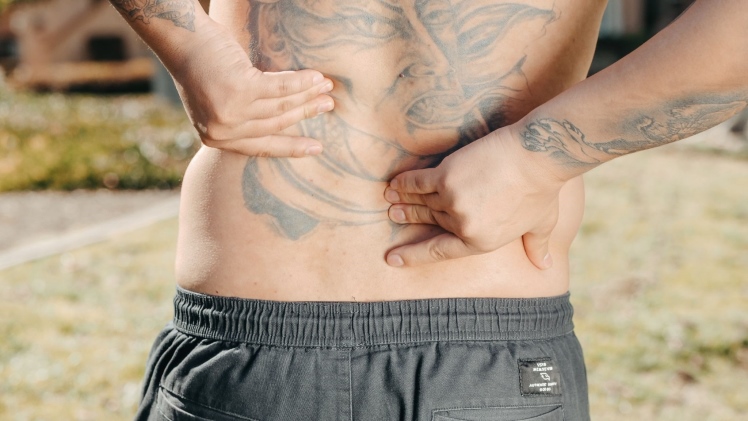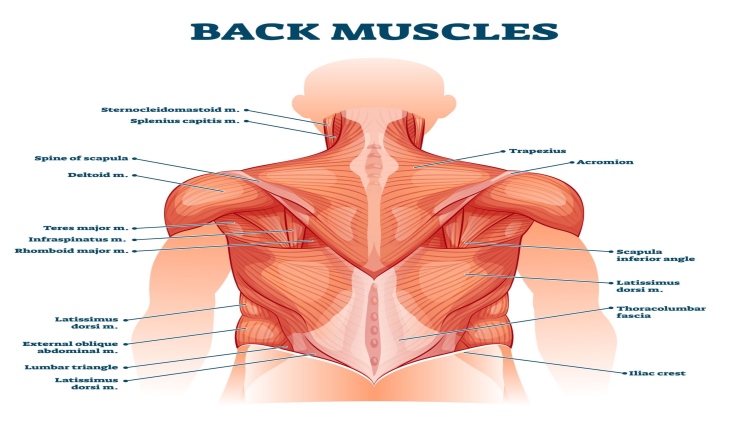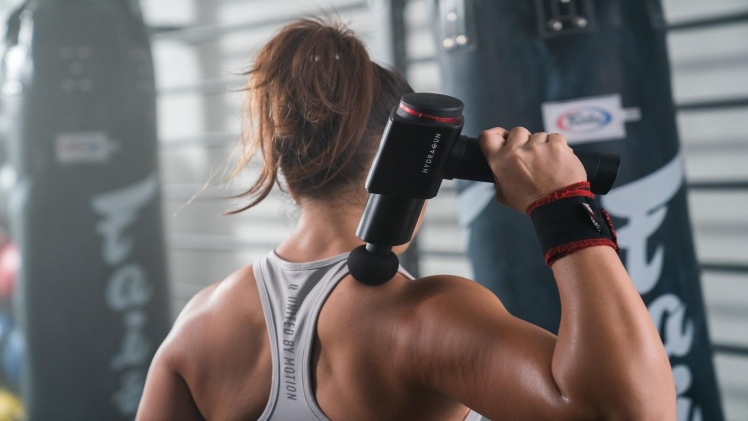There’s a growing hype around the massage gun as a physical therapy. It has become the go-to recovery tool for gym rats, homemakers, and desk job hustlers alike. And they all have one thing in common: the dreadingly frequent bouts of back pain.
So does a massage gun really do your back any favors? Read along to find out.
How massage guns fix your back pain
Back pain often comes from muscle fatigue or tension – two things that massage guns are incredibly efficient with. A study even finds that massage can be as effective of a painkiller as NSAIDs are.
Relieve muscle fatigue

Photo by Scott Webb from Pexels
Prolonged or intense physical activity strains your back muscles like any other. Going for a long run or repeatedly lifting heavy can both make your lower back sore. Even sitting all day takes a lot for your whole back to support.
A massage gun is capable of immediately blocking the pain signals to your brain. This allows it to address acute muscle soreness and DOMS with less struggle. By simulating your blood and lymphatic flows, it also helps your muscles heal faster.
Resolve muscle knots

Photo by Kindel Media from Pexels
Pushing your muscles past their limit can also result in persistent muscle tension. Muscle knots are distinguished by the small areas in which the tightness is localized. And they can hinder your body’s functions and cause lingering pain.
A good percussion massager can penetrate deep into your muscles to untangle these troublesome knots. This would also stop them from pinching other sensitive areas.
Reduce sources of nerve pain
Photo by Kindel Media from Pexels
Muscle knots and fatigue can both lead to nerve-pinching. Conditions like Sciatica can happen when the sciatic nerve running from down from your lower back is compressed. And it can spread pain and numbness down to your legs and feet.
Your back is a complex structure. And if you ignore its troubles, things can easily go south. By resolving muscle-related problems, a massage gun can help you spare your nerves from potential damage.
What the massage gun can’t fix on its own
Photo by cottonbro from Pexels
Like other forms of therapy, a massage gun has its limitations. And it would take your own wisdom to get the most relief it can offer.
Major injuries
For starters, massage guns are not designed to tackle injuries head-on. For anything that’s fractured or torn, there’s no better solution than leaving it unbothered.
Your best bet with a massage gun, however, is injury prevention. It can spare your muscles from cumulative damage by encouraging them to rebuild faster. And it can make your muscles more mobile, helping them protect your spine.
Structural problems
Fully resolving bone conditions and injuries require further medical attention. And it’s your doctor’s call whether a massage gun is safe for you.
That’s because massage guns are not designed for joints and bony areas – let alone injured ones. Your bones are simply too stiff and your ligaments are too fragile for the intensity.
There are conditions where a massage gun can help you ease the pain, though. With Scoliosis, for example, it can alleviate the muscle knots caused by the irregular spine curvature.
Using a massage gun for back pain
Photos by HYDRAGUN
The hallmark of a good massage gun is its ability to offer many choices without giving you option paralysis. It comes with several attachments to safely hit different targets. And it also provides adjustable speeds to suit different needs.
Photo by HYDRAGUN
At its full potential, a massage gun will help you look after the different areas in your back. It also pairs well with simple stretching exercises for best results.
Neck pain
Photo by VectorMine from Shutterstock
This may sound tricky, but it’s definitely doable. So let’s start with something intuitive: don’t apply the percussion massager directly on your neck. It contains too little muscle and too many vulnerable nerves and blood vessels, anyways.
There are muscles on your shoulder and upper back that are connected to your neck, though. You can go for those muscles instead.
You would want to target the area between the neck and shoulder for this. Start with the ball attachment. And if you need more depth, go for the fork one. Rest the massage gun on your target area for a few seconds and avoid hitting bone.
Upper back pain
Photo by VectorMine from Shutterstock
Also known as the thoracic region, your upper back contains muscles that protect vital organs and stabilize the torso. And it’s a common victim of bad posture and lifting mishaps.
For general relief, you can use a ball attachment on the smaller muscles around your shoulder blades. While your lats, the larger muscles below them, can benefit from a flat head attachment, too. While for a deeper penetration on muscle knots, a bullet head works best.
You can also use a fork attachment to completely avoid the spine, massaging either side of it. All you need is 10-15 seconds per muscle group, and not any longer.
Lower back
Photo by medicalstocks from Shutterstock
Your anchor of a lumbar area takes quite the beating from your everyday activities. And here, your lumbar multifidus and quadratus lumborum (QL) muscles work hard to keep things in order. These muscles even help with breathing, too.
Massaging these muscles, along with your gluteus medius, can help ease pain on your lower back. A flat head attachment would suit these muscles to ease away the soreness. For deep muscle knots, however, a fork attachment would be in order.
Float your massage gun along the muscle fibers for no more than 2 minutes, completely avoiding your bones.
The Bottomline
Your back is full of the hardest-working muscles in your body. They protect your most vital parts and give a lot to your movements and stability.
It’s the massage gun’s role in muscle health that makes it a great tool for your back troubles. But it’s also gonna take your efforts to use it right and keep everything else in order.
That said, navigating through back pain is understandably tricky. And administering self-therapy with a massage gun is only one part of managing it. It’s always important to exercise often and communicate with your doctor.

